The 1951 Refugee Convention: Relevancy Analysis with Legal Cases
VerifiedAdded on 2021/01/04
|8
|3185
|246
Essay
AI Summary
This essay critically appraises the ongoing relevance of the 1951 Refugee Convention, a pivotal international treaty defining refugee status and outlining protections. The paper acknowledges the convention's historical significance, arising from the aftermath of World War II and the subsequent need to protect displaced Europeans. It examines the convention's core elements, including the definition of a refugee based on a well-founded fear of persecution, and the principle of non-refoulement. However, it also addresses contemporary challenges, such as evolving interpretations of the refugee definition by UNHCR, the treatment of victims of trafficking, and gender-based persecution. The essay further considers the rights afforded to refugees, like freedom of movement and access to family life. The paper concludes by acknowledging the convention's limitations, including its original focus, and its exclusion of certain groups, while emphasizing the persistent need for refugee protection amid ongoing conflicts and displacement, and suggesting that the convention, despite its age, remains a fundamental instrument in international law.
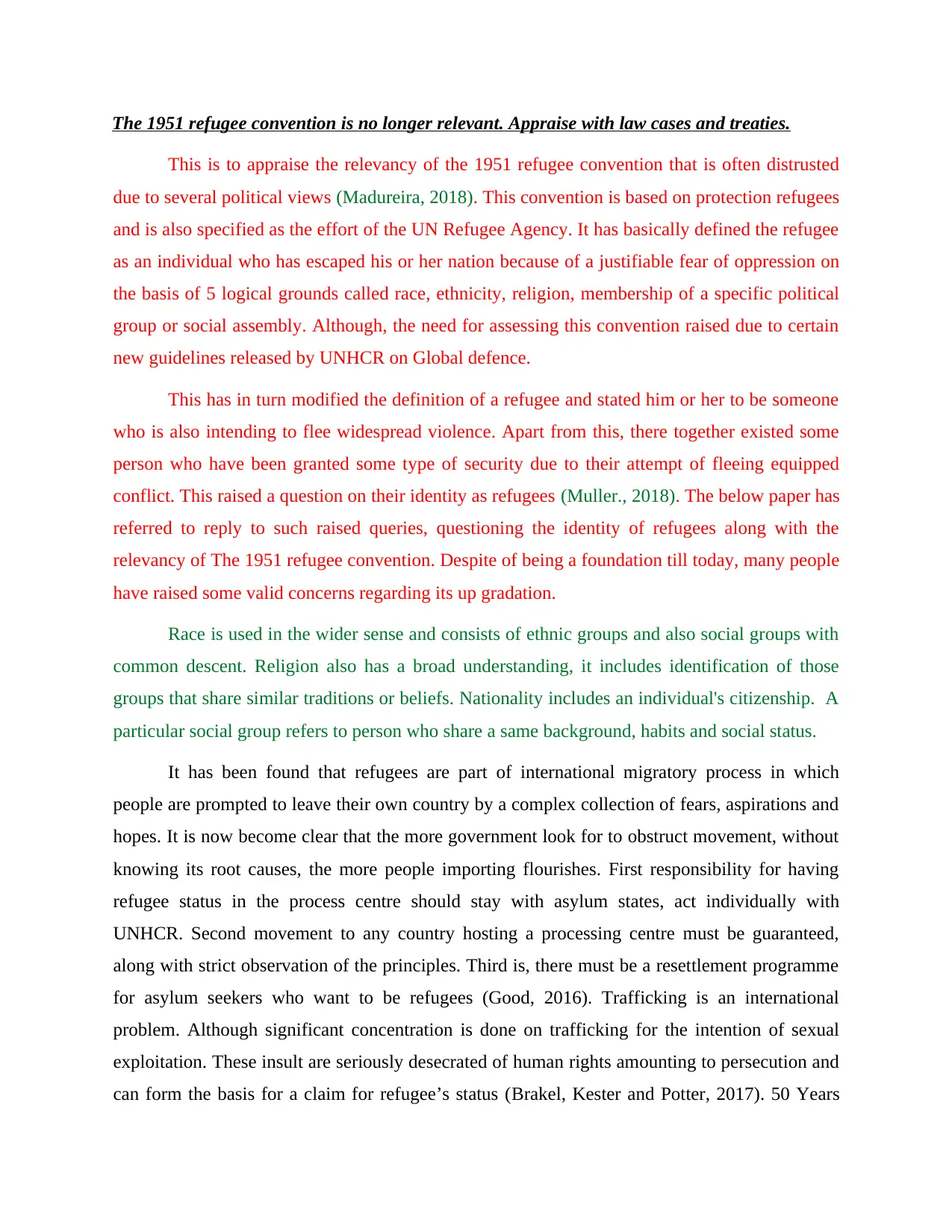
The 1951 refugee convention is no longer relevant. Appraise with law cases and treaties.
This is to appraise the relevancy of the 1951 refugee convention that is often distrusted
due to several political views (Madureira, 2018). This convention is based on protection refugees
and is also specified as the effort of the UN Refugee Agency. It has basically defined the refugee
as an individual who has escaped his or her nation because of a justifiable fear of oppression on
the basis of 5 logical grounds called race, ethnicity, religion, membership of a specific political
group or social assembly. Although, the need for assessing this convention raised due to certain
new guidelines released by UNHCR on Global defence.
This has in turn modified the definition of a refugee and stated him or her to be someone
who is also intending to flee widespread violence. Apart from this, there together existed some
person who have been granted some type of security due to their attempt of fleeing equipped
conflict. This raised a question on their identity as refugees (Muller., 2018). The below paper has
referred to reply to such raised queries, questioning the identity of refugees along with the
relevancy of The 1951 refugee convention. Despite of being a foundation till today, many people
have raised some valid concerns regarding its up gradation.
Race is used in the wider sense and consists of ethnic groups and also social groups with
common descent. Religion also has a broad understanding, it includes identification of those
groups that share similar traditions or beliefs. Nationality includes an individual's citizenship. A
particular social group refers to person who share a same background, habits and social status.
It has been found that refugees are part of international migratory process in which
people are prompted to leave their own country by a complex collection of fears, aspirations and
hopes. It is now become clear that the more government look for to obstruct movement, without
knowing its root causes, the more people importing flourishes. First responsibility for having
refugee status in the process centre should stay with asylum states, act individually with
UNHCR. Second movement to any country hosting a processing centre must be guaranteed,
along with strict observation of the principles. Third is, there must be a resettlement programme
for asylum seekers who want to be refugees (Good, 2016). Trafficking is an international
problem. Although significant concentration is done on trafficking for the intention of sexual
exploitation. These insult are seriously desecrated of human rights amounting to persecution and
can form the basis for a claim for refugee’s status (Brakel, Kester and Potter, 2017). 50 Years
This is to appraise the relevancy of the 1951 refugee convention that is often distrusted
due to several political views (Madureira, 2018). This convention is based on protection refugees
and is also specified as the effort of the UN Refugee Agency. It has basically defined the refugee
as an individual who has escaped his or her nation because of a justifiable fear of oppression on
the basis of 5 logical grounds called race, ethnicity, religion, membership of a specific political
group or social assembly. Although, the need for assessing this convention raised due to certain
new guidelines released by UNHCR on Global defence.
This has in turn modified the definition of a refugee and stated him or her to be someone
who is also intending to flee widespread violence. Apart from this, there together existed some
person who have been granted some type of security due to their attempt of fleeing equipped
conflict. This raised a question on their identity as refugees (Muller., 2018). The below paper has
referred to reply to such raised queries, questioning the identity of refugees along with the
relevancy of The 1951 refugee convention. Despite of being a foundation till today, many people
have raised some valid concerns regarding its up gradation.
Race is used in the wider sense and consists of ethnic groups and also social groups with
common descent. Religion also has a broad understanding, it includes identification of those
groups that share similar traditions or beliefs. Nationality includes an individual's citizenship. A
particular social group refers to person who share a same background, habits and social status.
It has been found that refugees are part of international migratory process in which
people are prompted to leave their own country by a complex collection of fears, aspirations and
hopes. It is now become clear that the more government look for to obstruct movement, without
knowing its root causes, the more people importing flourishes. First responsibility for having
refugee status in the process centre should stay with asylum states, act individually with
UNHCR. Second movement to any country hosting a processing centre must be guaranteed,
along with strict observation of the principles. Third is, there must be a resettlement programme
for asylum seekers who want to be refugees (Good, 2016). Trafficking is an international
problem. Although significant concentration is done on trafficking for the intention of sexual
exploitation. These insult are seriously desecrated of human rights amounting to persecution and
can form the basis for a claim for refugee’s status (Brakel, Kester and Potter, 2017). 50 Years
Paraphrase This Document
Need a fresh take? Get an instant paraphrase of this document with our AI Paraphraser
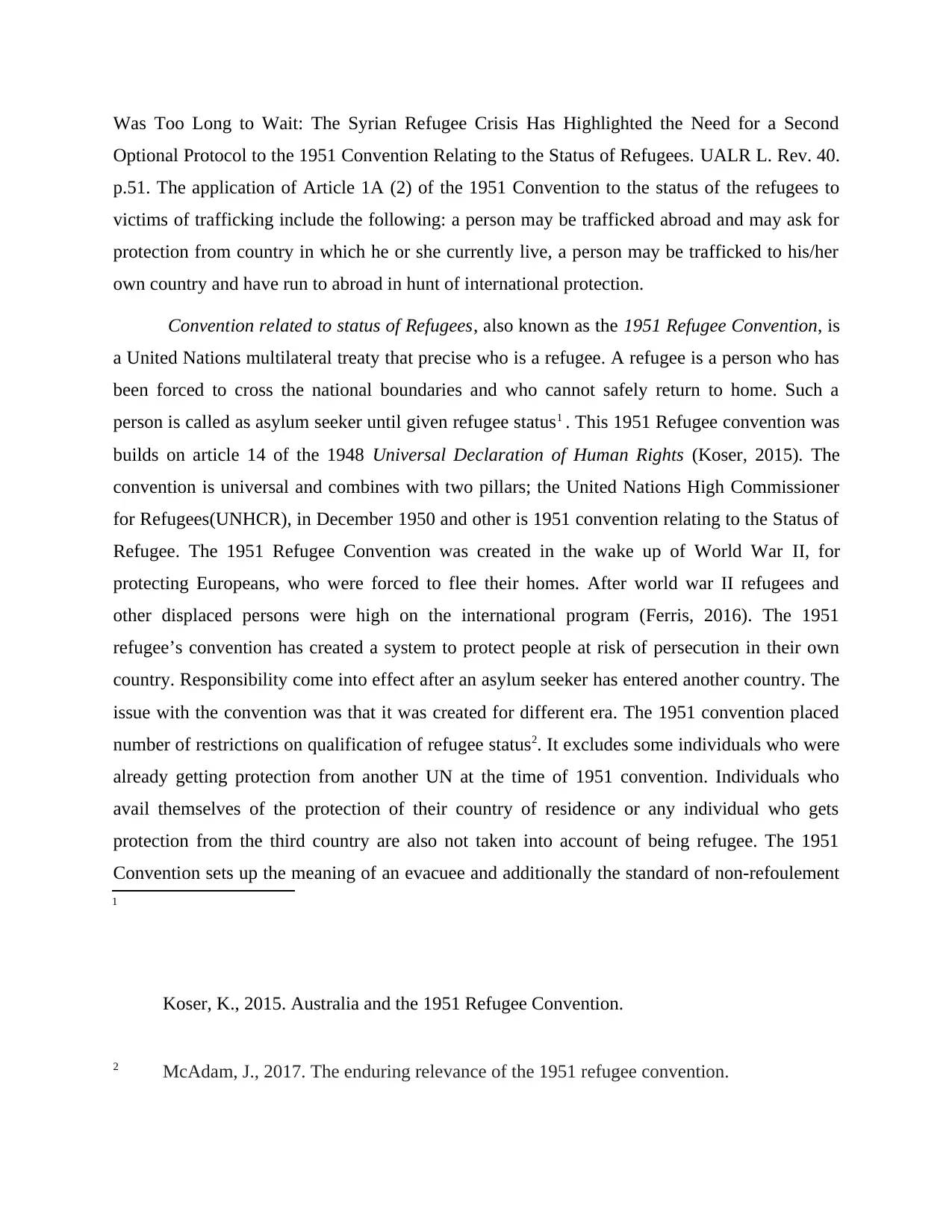
Was Too Long to Wait: The Syrian Refugee Crisis Has Highlighted the Need for a Second
Optional Protocol to the 1951 Convention Relating to the Status of Refugees. UALR L. Rev. 40.
p.51. The application of Article 1A (2) of the 1951 Convention to the status of the refugees to
victims of trafficking include the following: a person may be trafficked abroad and may ask for
protection from country in which he or she currently live, a person may be trafficked to his/her
own country and have run to abroad in hunt of international protection.
Convention related to status of Refugees, also known as the 1951 Refugee Convention, is
a United Nations multilateral treaty that precise who is a refugee. A refugee is a person who has
been forced to cross the national boundaries and who cannot safely return to home. Such a
person is called as asylum seeker until given refugee status1 . This 1951 Refugee convention was
builds on article 14 of the 1948 Universal Declaration of Human Rights (Koser, 2015). The
convention is universal and combines with two pillars; the United Nations High Commissioner
for Refugees(UNHCR), in December 1950 and other is 1951 convention relating to the Status of
Refugee. The 1951 Refugee Convention was created in the wake up of World War II, for
protecting Europeans, who were forced to flee their homes. After world war II refugees and
other displaced persons were high on the international program (Ferris, 2016). The 1951
refugee’s convention has created a system to protect people at risk of persecution in their own
country. Responsibility come into effect after an asylum seeker has entered another country. The
issue with the convention was that it was created for different era. The 1951 convention placed
number of restrictions on qualification of refugee status2. It excludes some individuals who were
already getting protection from another UN at the time of 1951 convention. Individuals who
avail themselves of the protection of their country of residence or any individual who gets
protection from the third country are also not taken into account of being refugee. The 1951
Convention sets up the meaning of an evacuee and additionally the standard of non-refoulement
1
Koser, K., 2015. Australia and the 1951 Refugee Convention.
2 McAdam, J., 2017. The enduring relevance of the 1951 refugee convention.
Optional Protocol to the 1951 Convention Relating to the Status of Refugees. UALR L. Rev. 40.
p.51. The application of Article 1A (2) of the 1951 Convention to the status of the refugees to
victims of trafficking include the following: a person may be trafficked abroad and may ask for
protection from country in which he or she currently live, a person may be trafficked to his/her
own country and have run to abroad in hunt of international protection.
Convention related to status of Refugees, also known as the 1951 Refugee Convention, is
a United Nations multilateral treaty that precise who is a refugee. A refugee is a person who has
been forced to cross the national boundaries and who cannot safely return to home. Such a
person is called as asylum seeker until given refugee status1 . This 1951 Refugee convention was
builds on article 14 of the 1948 Universal Declaration of Human Rights (Koser, 2015). The
convention is universal and combines with two pillars; the United Nations High Commissioner
for Refugees(UNHCR), in December 1950 and other is 1951 convention relating to the Status of
Refugee. The 1951 Refugee Convention was created in the wake up of World War II, for
protecting Europeans, who were forced to flee their homes. After world war II refugees and
other displaced persons were high on the international program (Ferris, 2016). The 1951
refugee’s convention has created a system to protect people at risk of persecution in their own
country. Responsibility come into effect after an asylum seeker has entered another country. The
issue with the convention was that it was created for different era. The 1951 convention placed
number of restrictions on qualification of refugee status2. It excludes some individuals who were
already getting protection from another UN at the time of 1951 convention. Individuals who
avail themselves of the protection of their country of residence or any individual who gets
protection from the third country are also not taken into account of being refugee. The 1951
Convention sets up the meaning of an evacuee and additionally the standard of non-refoulement
1
Koser, K., 2015. Australia and the 1951 Refugee Convention.
2 McAdam, J., 2017. The enduring relevance of the 1951 refugee convention.
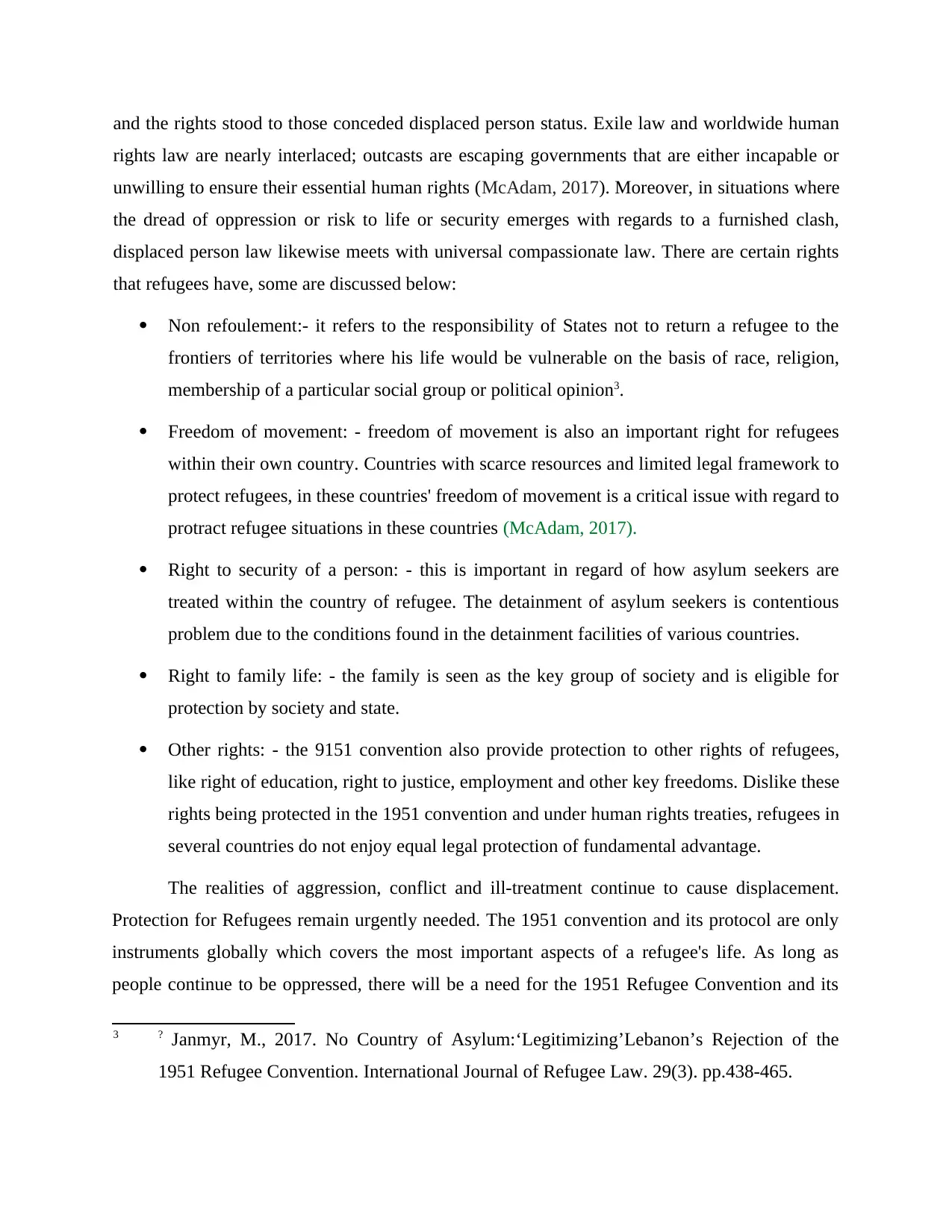
and the rights stood to those conceded displaced person status. Exile law and worldwide human
rights law are nearly interlaced; outcasts are escaping governments that are either incapable or
unwilling to ensure their essential human rights (McAdam, 2017). Moreover, in situations where
the dread of oppression or risk to life or security emerges with regards to a furnished clash,
displaced person law likewise meets with universal compassionate law. There are certain rights
that refugees have, some are discussed below:
Non refoulement:- it refers to the responsibility of States not to return a refugee to the
frontiers of territories where his life would be vulnerable on the basis of race, religion,
membership of a particular social group or political opinion3.
Freedom of movement: - freedom of movement is also an important right for refugees
within their own country. Countries with scarce resources and limited legal framework to
protect refugees, in these countries' freedom of movement is a critical issue with regard to
protract refugee situations in these countries (McAdam, 2017).
Right to security of a person: - this is important in regard of how asylum seekers are
treated within the country of refugee. The detainment of asylum seekers is contentious
problem due to the conditions found in the detainment facilities of various countries.
Right to family life: - the family is seen as the key group of society and is eligible for
protection by society and state.
Other rights: - the 9151 convention also provide protection to other rights of refugees,
like right of education, right to justice, employment and other key freedoms. Dislike these
rights being protected in the 1951 convention and under human rights treaties, refugees in
several countries do not enjoy equal legal protection of fundamental advantage.
The realities of aggression, conflict and ill-treatment continue to cause displacement.
Protection for Refugees remain urgently needed. The 1951 convention and its protocol are only
instruments globally which covers the most important aspects of a refugee's life. As long as
people continue to be oppressed, there will be a need for the 1951 Refugee Convention and its
3 ? Janmyr, M., 2017. No Country of Asylum:‘Legitimizing’Lebanon’s Rejection of the
1951 Refugee Convention. International Journal of Refugee Law. 29(3). pp.438-465.
rights law are nearly interlaced; outcasts are escaping governments that are either incapable or
unwilling to ensure their essential human rights (McAdam, 2017). Moreover, in situations where
the dread of oppression or risk to life or security emerges with regards to a furnished clash,
displaced person law likewise meets with universal compassionate law. There are certain rights
that refugees have, some are discussed below:
Non refoulement:- it refers to the responsibility of States not to return a refugee to the
frontiers of territories where his life would be vulnerable on the basis of race, religion,
membership of a particular social group or political opinion3.
Freedom of movement: - freedom of movement is also an important right for refugees
within their own country. Countries with scarce resources and limited legal framework to
protect refugees, in these countries' freedom of movement is a critical issue with regard to
protract refugee situations in these countries (McAdam, 2017).
Right to security of a person: - this is important in regard of how asylum seekers are
treated within the country of refugee. The detainment of asylum seekers is contentious
problem due to the conditions found in the detainment facilities of various countries.
Right to family life: - the family is seen as the key group of society and is eligible for
protection by society and state.
Other rights: - the 9151 convention also provide protection to other rights of refugees,
like right of education, right to justice, employment and other key freedoms. Dislike these
rights being protected in the 1951 convention and under human rights treaties, refugees in
several countries do not enjoy equal legal protection of fundamental advantage.
The realities of aggression, conflict and ill-treatment continue to cause displacement.
Protection for Refugees remain urgently needed. The 1951 convention and its protocol are only
instruments globally which covers the most important aspects of a refugee's life. As long as
people continue to be oppressed, there will be a need for the 1951 Refugee Convention and its
3 ? Janmyr, M., 2017. No Country of Asylum:‘Legitimizing’Lebanon’s Rejection of the
1951 Refugee Convention. International Journal of Refugee Law. 29(3). pp.438-465.
⊘ This is a preview!⊘
Do you want full access?
Subscribe today to unlock all pages.

Trusted by 1+ million students worldwide

1967 Protocol 4. The convention has presented a noteworthy resilience over last 60 years as the
nature of battle as well as patterns of movement have changed. UNHCR was created to seek
international protection and permanent solution for refugees. UNHCR's contribution in
protecting refugees by; promoting accession to refugee’s convention and laws, ensuring that
refugees are treated according to the internationally recognised legalised standards, and seeking
permanent solutions for them (Janmyr, 2017). UNHCR serves as the defender of the 1951
convention. The 1951 Refugee Convention provides that States are required to cooperate with
UNHCR in ensuring that the refugee rights are reputable and protected. The 1951 convention
only provides protection to those people who meet the criteria for status of refugee. Some
categorised people do not deserve refugee protection and are excluded from such protection. This
involves people for whom there are serious reasons to suspect that: they have committed a crime
against peace, a crime against humankind or they are at fault of acts different to the purpose and
principles of the United Nations5. The 1951 Convention was never meant to be a permanent
instrument for migration settlement.
The 1951 Refugee Convention does not protect those against all kind of harm. Gender
has been neglected in the representation of the 1951 Convention. Gender plays an important role
in shaping experience of persecution. In several countries women face the same harm which is
common to other refugees (Singer, 2017). If a person wants to adopt gender perspective in the
area of giving refugee status, he has to consider many aspects and undertake an investigation of
the process of obtaining asylum. Women suffering violence and discrimination does not have
equal opportunities like men. In absence of gender at the convention ground within the 1951
refugee convention, means that there is discussion about how gender issues in the asylum claim
are dealt with under international law. UNHCR has also introduced some guidance on
membership of a particular social group, on the Refugee Convention application, in cases
4 Good, A., 2016. Persecution for reasons of religion under the 1951 Refugee Convention.
In Permutations of Order (pp. 27-48). Routledge.
5 ? Happold, M. and Pichou, M., 2016. Protection of Persons Fleeing Armed Conflict and
Other Situations of Violence Assessing Claims for International Protection Under Article
1a (2) of the 1951 Convention and Article 15 of the EU Qualification Directive.
nature of battle as well as patterns of movement have changed. UNHCR was created to seek
international protection and permanent solution for refugees. UNHCR's contribution in
protecting refugees by; promoting accession to refugee’s convention and laws, ensuring that
refugees are treated according to the internationally recognised legalised standards, and seeking
permanent solutions for them (Janmyr, 2017). UNHCR serves as the defender of the 1951
convention. The 1951 Refugee Convention provides that States are required to cooperate with
UNHCR in ensuring that the refugee rights are reputable and protected. The 1951 convention
only provides protection to those people who meet the criteria for status of refugee. Some
categorised people do not deserve refugee protection and are excluded from such protection. This
involves people for whom there are serious reasons to suspect that: they have committed a crime
against peace, a crime against humankind or they are at fault of acts different to the purpose and
principles of the United Nations5. The 1951 Convention was never meant to be a permanent
instrument for migration settlement.
The 1951 Refugee Convention does not protect those against all kind of harm. Gender
has been neglected in the representation of the 1951 Convention. Gender plays an important role
in shaping experience of persecution. In several countries women face the same harm which is
common to other refugees (Singer, 2017). If a person wants to adopt gender perspective in the
area of giving refugee status, he has to consider many aspects and undertake an investigation of
the process of obtaining asylum. Women suffering violence and discrimination does not have
equal opportunities like men. In absence of gender at the convention ground within the 1951
refugee convention, means that there is discussion about how gender issues in the asylum claim
are dealt with under international law. UNHCR has also introduced some guidance on
membership of a particular social group, on the Refugee Convention application, in cases
4 Good, A., 2016. Persecution for reasons of religion under the 1951 Refugee Convention.
In Permutations of Order (pp. 27-48). Routledge.
5 ? Happold, M. and Pichou, M., 2016. Protection of Persons Fleeing Armed Conflict and
Other Situations of Violence Assessing Claims for International Protection Under Article
1a (2) of the 1951 Convention and Article 15 of the EU Qualification Directive.
Paraphrase This Document
Need a fresh take? Get an instant paraphrase of this document with our AI Paraphraser
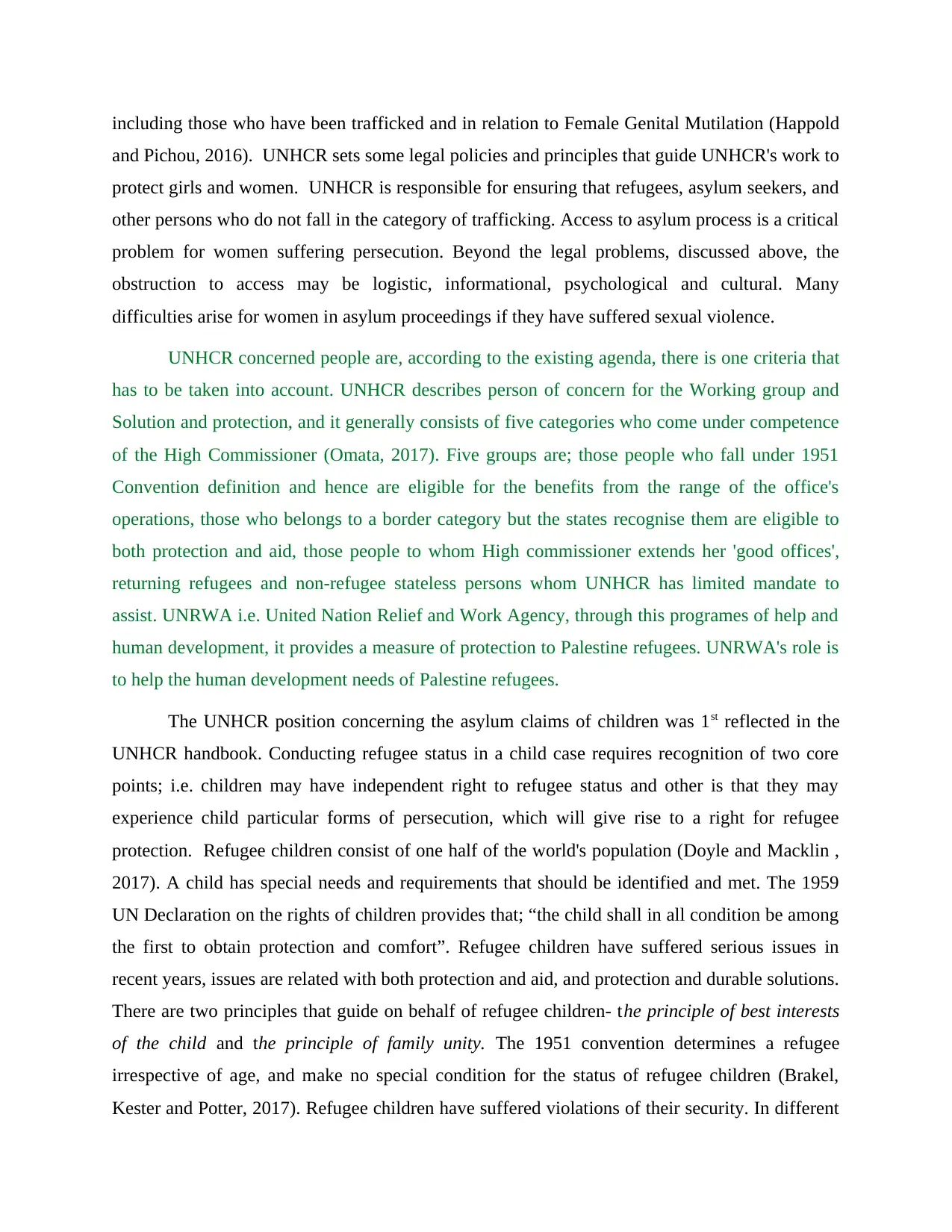
including those who have been trafficked and in relation to Female Genital Mutilation (Happold
and Pichou, 2016). UNHCR sets some legal policies and principles that guide UNHCR's work to
protect girls and women. UNHCR is responsible for ensuring that refugees, asylum seekers, and
other persons who do not fall in the category of trafficking. Access to asylum process is a critical
problem for women suffering persecution. Beyond the legal problems, discussed above, the
obstruction to access may be logistic, informational, psychological and cultural. Many
difficulties arise for women in asylum proceedings if they have suffered sexual violence.
UNHCR concerned people are, according to the existing agenda, there is one criteria that
has to be taken into account. UNHCR describes person of concern for the Working group and
Solution and protection, and it generally consists of five categories who come under competence
of the High Commissioner (Omata, 2017). Five groups are; those people who fall under 1951
Convention definition and hence are eligible for the benefits from the range of the office's
operations, those who belongs to a border category but the states recognise them are eligible to
both protection and aid, those people to whom High commissioner extends her 'good offices',
returning refugees and non-refugee stateless persons whom UNHCR has limited mandate to
assist. UNRWA i.e. United Nation Relief and Work Agency, through this programes of help and
human development, it provides a measure of protection to Palestine refugees. UNRWA's role is
to help the human development needs of Palestine refugees.
The UNHCR position concerning the asylum claims of children was 1st reflected in the
UNHCR handbook. Conducting refugee status in a child case requires recognition of two core
points; i.e. children may have independent right to refugee status and other is that they may
experience child particular forms of persecution, which will give rise to a right for refugee
protection. Refugee children consist of one half of the world's population (Doyle and Macklin ,
2017). A child has special needs and requirements that should be identified and met. The 1959
UN Declaration on the rights of children provides that; “the child shall in all condition be among
the first to obtain protection and comfort”. Refugee children have suffered serious issues in
recent years, issues are related with both protection and aid, and protection and durable solutions.
There are two principles that guide on behalf of refugee children- the principle of best interests
of the child and the principle of family unity. The 1951 convention determines a refugee
irrespective of age, and make no special condition for the status of refugee children (Brakel,
Kester and Potter, 2017). Refugee children have suffered violations of their security. In different
and Pichou, 2016). UNHCR sets some legal policies and principles that guide UNHCR's work to
protect girls and women. UNHCR is responsible for ensuring that refugees, asylum seekers, and
other persons who do not fall in the category of trafficking. Access to asylum process is a critical
problem for women suffering persecution. Beyond the legal problems, discussed above, the
obstruction to access may be logistic, informational, psychological and cultural. Many
difficulties arise for women in asylum proceedings if they have suffered sexual violence.
UNHCR concerned people are, according to the existing agenda, there is one criteria that
has to be taken into account. UNHCR describes person of concern for the Working group and
Solution and protection, and it generally consists of five categories who come under competence
of the High Commissioner (Omata, 2017). Five groups are; those people who fall under 1951
Convention definition and hence are eligible for the benefits from the range of the office's
operations, those who belongs to a border category but the states recognise them are eligible to
both protection and aid, those people to whom High commissioner extends her 'good offices',
returning refugees and non-refugee stateless persons whom UNHCR has limited mandate to
assist. UNRWA i.e. United Nation Relief and Work Agency, through this programes of help and
human development, it provides a measure of protection to Palestine refugees. UNRWA's role is
to help the human development needs of Palestine refugees.
The UNHCR position concerning the asylum claims of children was 1st reflected in the
UNHCR handbook. Conducting refugee status in a child case requires recognition of two core
points; i.e. children may have independent right to refugee status and other is that they may
experience child particular forms of persecution, which will give rise to a right for refugee
protection. Refugee children consist of one half of the world's population (Doyle and Macklin ,
2017). A child has special needs and requirements that should be identified and met. The 1959
UN Declaration on the rights of children provides that; “the child shall in all condition be among
the first to obtain protection and comfort”. Refugee children have suffered serious issues in
recent years, issues are related with both protection and aid, and protection and durable solutions.
There are two principles that guide on behalf of refugee children- the principle of best interests
of the child and the principle of family unity. The 1951 convention determines a refugee
irrespective of age, and make no special condition for the status of refugee children (Brakel,
Kester and Potter, 2017). Refugee children have suffered violations of their security. In different
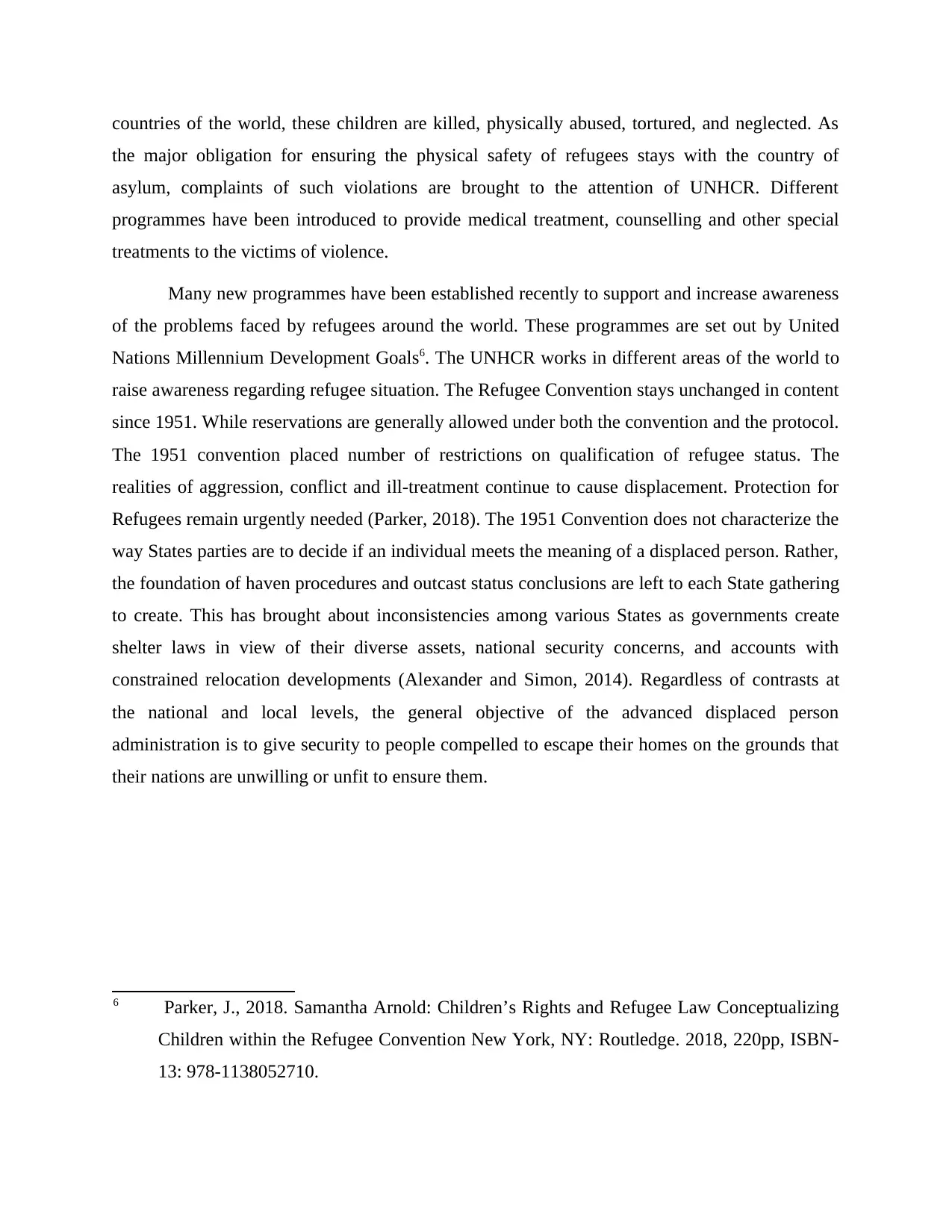
countries of the world, these children are killed, physically abused, tortured, and neglected. As
the major obligation for ensuring the physical safety of refugees stays with the country of
asylum, complaints of such violations are brought to the attention of UNHCR. Different
programmes have been introduced to provide medical treatment, counselling and other special
treatments to the victims of violence.
Many new programmes have been established recently to support and increase awareness
of the problems faced by refugees around the world. These programmes are set out by United
Nations Millennium Development Goals6. The UNHCR works in different areas of the world to
raise awareness regarding refugee situation. The Refugee Convention stays unchanged in content
since 1951. While reservations are generally allowed under both the convention and the protocol.
The 1951 convention placed number of restrictions on qualification of refugee status. The
realities of aggression, conflict and ill-treatment continue to cause displacement. Protection for
Refugees remain urgently needed (Parker, 2018). The 1951 Convention does not characterize the
way States parties are to decide if an individual meets the meaning of a displaced person. Rather,
the foundation of haven procedures and outcast status conclusions are left to each State gathering
to create. This has brought about inconsistencies among various States as governments create
shelter laws in view of their diverse assets, national security concerns, and accounts with
constrained relocation developments (Alexander and Simon, 2014). Regardless of contrasts at
the national and local levels, the general objective of the advanced displaced person
administration is to give security to people compelled to escape their homes on the grounds that
their nations are unwilling or unfit to ensure them.
6 Parker, J., 2018. Samantha Arnold: Children’s Rights and Refugee Law Conceptualizing
Children within the Refugee Convention New York, NY: Routledge. 2018, 220pp, ISBN-
13: 978-1138052710.
the major obligation for ensuring the physical safety of refugees stays with the country of
asylum, complaints of such violations are brought to the attention of UNHCR. Different
programmes have been introduced to provide medical treatment, counselling and other special
treatments to the victims of violence.
Many new programmes have been established recently to support and increase awareness
of the problems faced by refugees around the world. These programmes are set out by United
Nations Millennium Development Goals6. The UNHCR works in different areas of the world to
raise awareness regarding refugee situation. The Refugee Convention stays unchanged in content
since 1951. While reservations are generally allowed under both the convention and the protocol.
The 1951 convention placed number of restrictions on qualification of refugee status. The
realities of aggression, conflict and ill-treatment continue to cause displacement. Protection for
Refugees remain urgently needed (Parker, 2018). The 1951 Convention does not characterize the
way States parties are to decide if an individual meets the meaning of a displaced person. Rather,
the foundation of haven procedures and outcast status conclusions are left to each State gathering
to create. This has brought about inconsistencies among various States as governments create
shelter laws in view of their diverse assets, national security concerns, and accounts with
constrained relocation developments (Alexander and Simon, 2014). Regardless of contrasts at
the national and local levels, the general objective of the advanced displaced person
administration is to give security to people compelled to escape their homes on the grounds that
their nations are unwilling or unfit to ensure them.
6 Parker, J., 2018. Samantha Arnold: Children’s Rights and Refugee Law Conceptualizing
Children within the Refugee Convention New York, NY: Routledge. 2018, 220pp, ISBN-
13: 978-1138052710.
⊘ This is a preview!⊘
Do you want full access?
Subscribe today to unlock all pages.

Trusted by 1+ million students worldwide
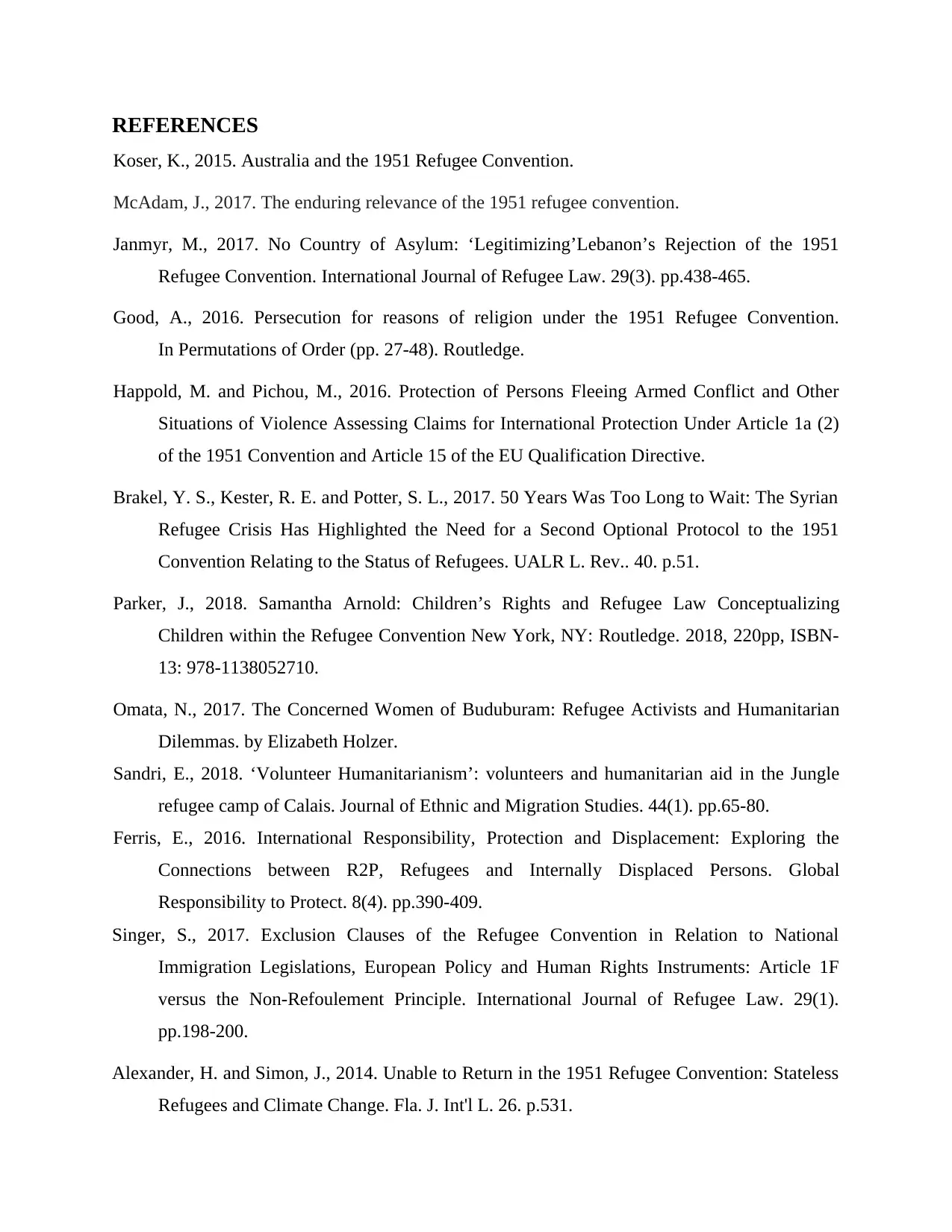
REFERENCES
Koser, K., 2015. Australia and the 1951 Refugee Convention.
McAdam, J., 2017. The enduring relevance of the 1951 refugee convention.
Janmyr, M., 2017. No Country of Asylum: ‘Legitimizing’Lebanon’s Rejection of the 1951
Refugee Convention. International Journal of Refugee Law. 29(3). pp.438-465.
Good, A., 2016. Persecution for reasons of religion under the 1951 Refugee Convention.
In Permutations of Order (pp. 27-48). Routledge.
Happold, M. and Pichou, M., 2016. Protection of Persons Fleeing Armed Conflict and Other
Situations of Violence Assessing Claims for International Protection Under Article 1a (2)
of the 1951 Convention and Article 15 of the EU Qualification Directive.
Brakel, Y. S., Kester, R. E. and Potter, S. L., 2017. 50 Years Was Too Long to Wait: The Syrian
Refugee Crisis Has Highlighted the Need for a Second Optional Protocol to the 1951
Convention Relating to the Status of Refugees. UALR L. Rev.. 40. p.51.
Parker, J., 2018. Samantha Arnold: Children’s Rights and Refugee Law Conceptualizing
Children within the Refugee Convention New York, NY: Routledge. 2018, 220pp, ISBN-
13: 978-1138052710.
Omata, N., 2017. The Concerned Women of Buduburam: Refugee Activists and Humanitarian
Dilemmas. by Elizabeth Holzer.
Sandri, E., 2018. ‘Volunteer Humanitarianism’: volunteers and humanitarian aid in the Jungle
refugee camp of Calais. Journal of Ethnic and Migration Studies. 44(1). pp.65-80.
Ferris, E., 2016. International Responsibility, Protection and Displacement: Exploring the
Connections between R2P, Refugees and Internally Displaced Persons. Global
Responsibility to Protect. 8(4). pp.390-409.
Singer, S., 2017. Exclusion Clauses of the Refugee Convention in Relation to National
Immigration Legislations, European Policy and Human Rights Instruments: Article 1F
versus the Non-Refoulement Principle. International Journal of Refugee Law. 29(1).
pp.198-200.
Alexander, H. and Simon, J., 2014. Unable to Return in the 1951 Refugee Convention: Stateless
Refugees and Climate Change. Fla. J. Int'l L. 26. p.531.
Koser, K., 2015. Australia and the 1951 Refugee Convention.
McAdam, J., 2017. The enduring relevance of the 1951 refugee convention.
Janmyr, M., 2017. No Country of Asylum: ‘Legitimizing’Lebanon’s Rejection of the 1951
Refugee Convention. International Journal of Refugee Law. 29(3). pp.438-465.
Good, A., 2016. Persecution for reasons of religion under the 1951 Refugee Convention.
In Permutations of Order (pp. 27-48). Routledge.
Happold, M. and Pichou, M., 2016. Protection of Persons Fleeing Armed Conflict and Other
Situations of Violence Assessing Claims for International Protection Under Article 1a (2)
of the 1951 Convention and Article 15 of the EU Qualification Directive.
Brakel, Y. S., Kester, R. E. and Potter, S. L., 2017. 50 Years Was Too Long to Wait: The Syrian
Refugee Crisis Has Highlighted the Need for a Second Optional Protocol to the 1951
Convention Relating to the Status of Refugees. UALR L. Rev.. 40. p.51.
Parker, J., 2018. Samantha Arnold: Children’s Rights and Refugee Law Conceptualizing
Children within the Refugee Convention New York, NY: Routledge. 2018, 220pp, ISBN-
13: 978-1138052710.
Omata, N., 2017. The Concerned Women of Buduburam: Refugee Activists and Humanitarian
Dilemmas. by Elizabeth Holzer.
Sandri, E., 2018. ‘Volunteer Humanitarianism’: volunteers and humanitarian aid in the Jungle
refugee camp of Calais. Journal of Ethnic and Migration Studies. 44(1). pp.65-80.
Ferris, E., 2016. International Responsibility, Protection and Displacement: Exploring the
Connections between R2P, Refugees and Internally Displaced Persons. Global
Responsibility to Protect. 8(4). pp.390-409.
Singer, S., 2017. Exclusion Clauses of the Refugee Convention in Relation to National
Immigration Legislations, European Policy and Human Rights Instruments: Article 1F
versus the Non-Refoulement Principle. International Journal of Refugee Law. 29(1).
pp.198-200.
Alexander, H. and Simon, J., 2014. Unable to Return in the 1951 Refugee Convention: Stateless
Refugees and Climate Change. Fla. J. Int'l L. 26. p.531.
Paraphrase This Document
Need a fresh take? Get an instant paraphrase of this document with our AI Paraphraser
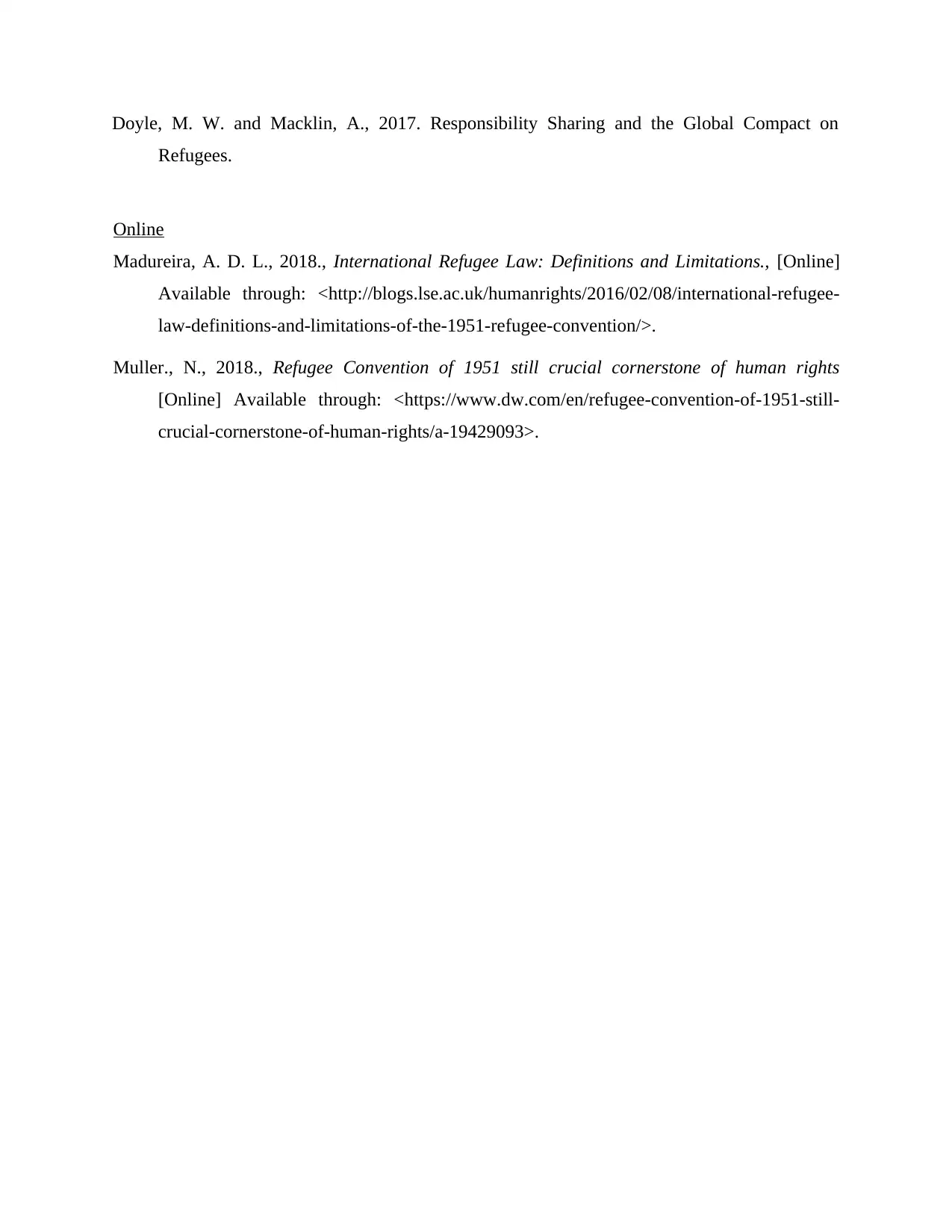
Doyle, M. W. and Macklin, A., 2017. Responsibility Sharing and the Global Compact on
Refugees.
Online
Madureira, A. D. L., 2018., International Refugee Law: Definitions and Limitations., [Online]
Available through: <http://blogs.lse.ac.uk/humanrights/2016/02/08/international-refugee-
law-definitions-and-limitations-of-the-1951-refugee-convention/>.
Muller., N., 2018., Refugee Convention of 1951 still crucial cornerstone of human rights
[Online] Available through: <https://www.dw.com/en/refugee-convention-of-1951-still-
crucial-cornerstone-of-human-rights/a-19429093>.
Refugees.
Online
Madureira, A. D. L., 2018., International Refugee Law: Definitions and Limitations., [Online]
Available through: <http://blogs.lse.ac.uk/humanrights/2016/02/08/international-refugee-
law-definitions-and-limitations-of-the-1951-refugee-convention/>.
Muller., N., 2018., Refugee Convention of 1951 still crucial cornerstone of human rights
[Online] Available through: <https://www.dw.com/en/refugee-convention-of-1951-still-
crucial-cornerstone-of-human-rights/a-19429093>.
1 out of 8
Related Documents
Your All-in-One AI-Powered Toolkit for Academic Success.
+13062052269
info@desklib.com
Available 24*7 on WhatsApp / Email
![[object Object]](/_next/static/media/star-bottom.7253800d.svg)
Unlock your academic potential
Copyright © 2020–2025 A2Z Services. All Rights Reserved. Developed and managed by ZUCOL.





